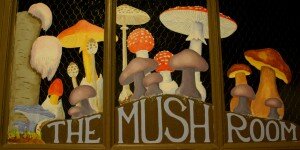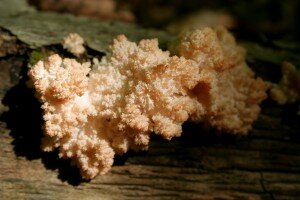Lion's Mane: A Foolproof Fungus
Log-grown H. erinaceus at a perfect stage for harvest. This species has long, non-branching spines.
The lion’s mane season has arrived, bringing white, cascading icicles from the forest to my plate! I conveniently use the common name “lion’s mane” to refer to a constellation of fungi of the genus Hericium, including the native northeastern representatives H. americanum and H. coralloides, as well as the commonly cultivated H. erinaceus. Most mycology texts call these three mushrooms bear’s-head tooth, comb tooth, and bearded tooth, respectively. Distinguishing amongst Hericium species can be difficult at first, but this is irrelevant to the forager interested in a good meal. Lion’s mane has no look-a-likes, edible or poisonous, and all forms are edible and delicious in the kitchen. With that said, Jenna does prefer the texture of H. erinaceus, which looks like a faceless hedgehog or a truffula tree out of Dr. Seuss’ The Lorax. Instead of H. erinaceus’ tight, pom-pom shaped clusters, H. americanum forms looser, interconnected clumps that look like the tufted form of a weeping willow tree. H. coralloides resembles H. americanum, but reminds me of branched brain coral with its shorter teeth.
A mature H. americanum fruiting on a downed beech tree. It appears just slightly overripe, as the teeth are fully extended and it is beginning to brown on the margins.
Fruiting occasionally in the spring but typically in the fall in the Northeast, lion’s mane is fairly common and easy to spot. This saprophytic fungus is not very discriminating when it comes to log selection, growing on many dead or dying hardwood trees including maple, beech, oak, birch, walnut, and sycamore. It can be cultivated indoors on sawdust or outdoors on logs or totems, though H. erinaceus is the only lion’s mane species you can readily buy spawn for on the Internet.
However, Jeanne Grace, a recent Masters student of Dr. Ken Mudge in Horticulture at Cornell University, cloned several strains of wild H. americanum growing near Ithaca and has had great success cultivating it on hardwood totems in its native habitat. The totems, which are created by sandwiching spawn between two large log butts, produced bumper crops both this summer and last, forming much bigger fruits than I have ever seen with H. erinaceus. The wild Hericium strains did not perform as well in her indoor experiments on sawdust in “The Mushroom,” a grow room in the Cornell Department of Horticulture’s Plant Science building. In this environment they “pinned,” but were unable to find their way out of the plastic bag to grow as their cultivated relative does.
Another log-grown H. erinaceus ready for harvest.
You usually have to wait a year from the inoculation date to enjoy cultivated lion’s mane, but the impatient mycophile can find lion’s mane in the woods right now! Last fall I stumbled upon a large, rotting log covered in frozen waterfalls of lion’s mane. I was so transfixed by the sight that it took me a few minutes to notice a hidden pocket in the log, harboring the biggest lion’s mane I have seen to date. The mushroom was bigger and heavier than a soccer ball! Today I returned to the spot, expecting either nothing or another jackpot. I got something in between; four medium sized lion’s mane clusters had fruited in the hollowed out portion of the log, all perfectly ripe. Two were covered in debris from the eroding ceiling of the log cavity in which they had formed, so I took the cleaner two and walked out of the forest a satisfied man.
"The Mushroom," in Cornell's Plant Science building
When not overripe, lion’s mane has a delicate seafoody flavor and sublime texture that reminds me of scallops. Cooking it perfectly takes practice, however. I like it best sautéed in butter and garlic on a medium heat, until it gets just slightly brown and crispy on the tips. Today’s lion’s mane I sautéed with sliced local apples in ginger, garlic, and butter. Yum! All lion’s mane species are very absorbent, so specimens should be squeezed out like a sponge after washing (or not washed at all if fairly clean when found). The mushroom holds up to a good wringing out surprisingly well, whereas sautéing wet lion’s mane spoils the texture.
A young wild lion’s mane specimen, probably H. americanum. The pinkish tone and tight clusters of short teeth indicate that it is still growing.
If you are fairly new to mushroom foraging, lion’s mane is a great species to start with. In the words of mycologist David Fischer, “If it looks like a cluster of white fungal icicles hanging off a decaying log, stump, or dead tree trunk, and it seems very fresh, bake it (or fry it slowly in a mix of butter and oil) and enjoy!”




